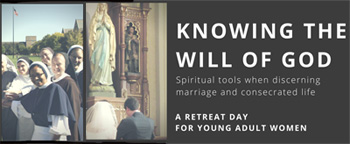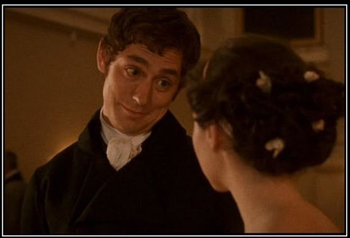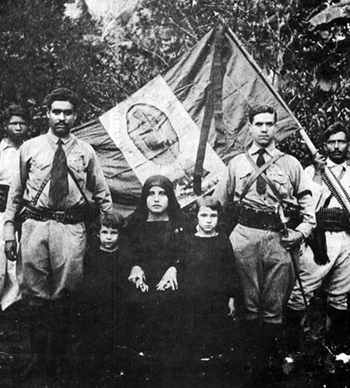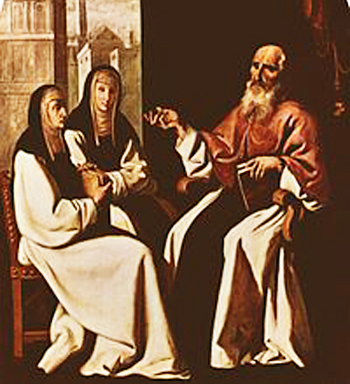Single Vocation :The Answer for a Broken World

A discernment retreat that ignores the single celibate life as an honorable vocation, higher than marriage
This erroneous idea about the vocation to be single can, therefore, be a source of great frustration, especially for those who are called to this life but are constantly dissuaded from it by those who follow the fashions and are ill-informed.
I hope to dispel this confusion and error by examining the vocation for lay celibacy more closely and, thus, show why it is the vocation that is perfectly suited to destroy the Revolution.
Vocations are ‘under construction’
The definition of vocations comes organically, from the ground up. When a certain vocational reality is presented to the Church, she defines it: In other words, the Church defines what comes as it comes.
She saw the Benedictines rise from the initial hermitage of St. Benedict of Nursia, the Dominicans from the zeal of St. Dominic in preaching against the heresies, the Jesuits from the desire of St. Ignatius to build an army for Jesus to conquer the world. Each one of the religious congregations that were born later had a similar history. The Church waits to see what is coming before trying to fit everyone into an already existing category.
She does not force a reality, she merely defines it. Vocations are based on the call of grace, which is made to assist the needs of the Church, and, consequently, vocations are in constant development.
I must say that as I am writing this, I had a strong reaction against this process when I learned about it. Why? It is because we Americans have a tendency to fit in to already known categories. This tendency may have something to do with the “computer culture” in which we were raised. Vocations are not like this.
The four vocations we know now (married, priest, religious, single) were defined in this organic process.
Vocations through the ages
The vocation to the priesthood has been around since the birth of the Church, but organized religious life as we know it did not come to its full fruition in the West until the monastic movement in the early Middle Ages. Up until that point, men and women decided to live a chaste life in prayer and sacrifice, many as consecrated virgins. Some lived in the world, and some chose to live as hermits, who were the precedents and founders of future religious orders. These men and women chose to live a life of chastity and virginity, dedicated to prayer and service for the needs of the Church.
In their time, there was no clear definition of their vocations – those celibate men and women simply wanted to not assume the life of marriage. They wanted to follow more closely in the footsteps of Our Lord as unmarried people.
After the expansion of monasteries and convents throughout Europe in the Middle Ages, the religious vocation often became the model for celibate life, since one could more easily live a chaste life as a religious rather than in the world.
It is wrong to think, however, that because of the prominence of religious life as a celibate vocation in the Church, the lay celibate life by itself was never a true vocation. There have been lay celibates since time immemorial. Our Lady and St. Joseph themselves were lay celibates before they married, and they kept the virginity of their previous life even after they were wed. There were many lay celibates in the beginning, including St. Benedict, St. Catherine of Siena, St. Rose of Lima and countless other saints.
Vatican II spoiled the single vocation
Another reason the single vocation has been treated as the “ugly duckling” in traditionalist circles is Vatican II. The Council over-promoted the role of the laity, putting it on par with and even higher than the clergy. For this reason, it is understandable that there was an explosive increase in lay celibate organizations and a huge decline in priests and religious vocations. After all, why should one be a priest or religious if it is not as great as being a layperson?
Traditionalists saw this and were rightly upset. However, they over-reacted in the opposite direction: They over-stressed the vocation to the priesthood for men and religious life for women. Their mistake was to disregard the single life as a vocation. Their reasoning seems to be: “Since Vatican II over-promoted the laity, the lay celibate vocation is not really a valid vocation. So, let's promote only the married life, priesthood and the religious life.”
This mistake is incorporated into a Protestant mentality that we are so accustomed to as Americans.
Protestantism & the unfulfilled woman
The idea that every person should marry is intrinsically Protestant. For women, it comes from the old English idea that the unmarried woman is an unfulfilled woman (e.g. Jane Austen). It is the idea that “God has someone for everyone, and if you don’t have someone, then that means God is your ‘someone,’ so you have to be a priest or religious.”

With Protestantism, life for women became the search of 'Mr. Right', the theme of Jane Austen novels
Not to see this is to deny that the Catholic Church should count on laypersons to help her. This is one of the results of the American Protestant influence. For this reason, traditional Catholics should purge this idea from their mentalities.
The single vocation as a weapon against the Revolution
The fact is that the Church needs lay celibates at this time. Why? It is because the Revolution infiltrated the Catholic Church through Progressivism and threatens to destroy her and our world. She needs lay celibates more than religious people and priests because most of the clergy and religious institutions are corrupted by bad doctrines and customs. Consequently, single laymen and women are much less infected by the revolutionary-progressivist virus and easier to convert to an anti-progressivist mindset.
Besides, in this vocation men and women can devote all their time to destroying the Revolution and building the Reign of Mary, which must be built on purity, something that lay celibacy has as a state of life.
Those who choose marriage cannot devote all their time to the Counter-Revolution because their time is consumed with making a living and raising sound Catholic children in the midst of a Revolutionary world, which is already a colossal task in itself. Priests and religious cannot devote all their time to the Counter-Revolution either, because they must spend their time administering the Sacraments or they are cloistered and bound by obedience to their superiors, who are all making concessions in some way or another since they are directly or indirectly linked to the progressivist Hierarchy.
Since we are in the midst of battle, the only logical choice is to fight, to focus all our time on destroying the enemy. In our day, the only vocation that is perfectly suited for this fight is the lay single life.
Young people and heroism
As a millennial, I can say that young people want to heroically fight for a cause and devote their whole life to it. Furthermore, we need this heroism today. A youthful vigor and militancy is the only thing that will destroy the Revolution and restore Christendom to its rightful splendor.

Young Cristeros heroically fighting for a Catholic ideal
“The great sense of the vocation of the generation of the present day youth today is sacrifice. Either this generation will face the hardness of its vocation with the generosity of martyrdom, or it will inevitably be demolished by the tempests that previous generations cumulated through their mistakes, and are about to fall upon the contemporary world.
“But the sacrifice required is not necessarily that of blood. It is not death that grace imposes on the youth of today as the supreme danger to face, but life itself. It is no longer the time for believers to attest to their faith by the bloody witness of martyrdom. What the Church today asks of its faithful is the witness of an exemplary life and the generous sacrifice of our whole persons to the great cause because it is necessary to fight.” (“The Indispensable Sacrifice” in The Legionario, São Paulo, n. 173, June 9, 1935)
I leave my readers to meditate on Dr. Plinio's inspiring words on the single vocation as I go to prepare my next article in this series.
To be continued
source


Um...how can being single be a vocation? Ripperger says vocation only applies to religious anyway, but who's the single commitment to? yourself?
ReplyDeleteRight on
DeleteThe single commitment is to God, a life of sacrifices and chastity. Purity is precious to God, just look at Our Blessed Mother! Another example would be the Saintly hermits, who also followed a single life of prayer and rejection of worldly pleasures, only wishing to glorify God.
ReplyDeleteexcellent, good to hear from you
DeleteThe answer is in the article, the "cause" being personal holiness lived out in one's life in the world, such as Maximillian Kolbe's Militia Immaculata, Third Order Traditional Dominicans, etc. There is historical precidence for this within the Church. "What the Church today asks of its faithful is the witness of an exemplary life and the generous sacrifice of our whole persons to the great CAUSE because it is necessary...”
ReplyDeleteDidn't St. Paul say that the single life was preferable to the married state ?
ReplyDeleteSt. Catherine of Siena AND her mother were both "Tertiaries" in the Dominican Third Order of Penance as are my daughter and I, along with my twins at our Dominican House of Prayer and Study, Maris Stella. West Coast. We have associated with the Traditional Dominican Priests and Brothers of the Holy Face. East Coast. God put all this together after I was threatened with "excommunication" by the Chaplain of the SD Lay (Vatican II) Dominicans for attending the "wrong" Latin Mass! This is where we all need some work as "Trads:" this group was indeed striving/living personal holiness, most of them young singles BUT church politics, pride and territoriality won the day. Then on their radio show the word "radical" was used in the same breath as Trad. Anyone not in step with Vatican II a terrorist. It is the same word, btw, used by Jacoben Revolutionaries in the "French Revolution," for "Catholic."
ReplyDeleteSt. Dominic's Last Will and Testament: "Have charity for one another, guard humiity, make your treasure out of voluntary poverty."
ReplyDeletecharity above all
DeleteThe Progressive Movement which we are engulfed in now is important to our understanding of present times. After the French Reformation/Revolution they took their fight against God into academia which is where "Leo Dupont" discovered and EXPOSED them. One of the books recommended to me by the Dominicans of Lawrence was HOLY MAN of TOURS: Leo Dupont by Scalon. I highly recommend it. 100 years later we call it Vatican II.
ReplyDeletethank you!
DeleteYou're welcome! :)
DeleteThere are (at least) TWO Holy Men of Tours, as today we celebrate St.Martin, Bishop of Tours
ReplyDelete/:)
Delete